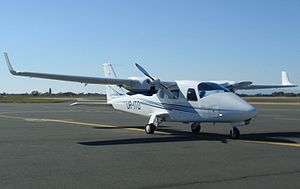Tecnam P2006T
| P2006T | |
|---|---|
 | |
| Tecnam 2006T on the ground | |
| Role | Four-seat light twin |
| National origin | Italy |
| Manufacturer | Tecnam |
| Designer | Luigi Pascale |
| First flight | 13 September 2007 |
| Introduction | 2010 |
| Status | In production, active |
| Number built | 578 (24/8/2017) |
| Unit cost |
US$443,900 [1] |
| Variants | Tecnam MMA |
| Developed into | NASA X-57 Maxwell |
The Tecnam P2006T is an Italian high-winged, twin-engined all-metal[2] light aircraft built by Costruzioni Aeronautiche Tecnam, which is based in Capua, Italy (near Naples). Certified in the European Union by EASA under CS23, the P2006T received Federal Aviation Administration FAR Part 23 certification in 2010.[3]
The P2006T is the lightest twin-engined certified aircraft available,[3] and is a four-seat aircraft with fully retractable landing gear and liquid-cooled Rotax engines that can run on 92 octane unleaded automotive gasoline as well as 100LL.[4]
Design
The P2006T is a twin-engined four-seat cantilever high-wing monoplane with a retractable tricycle landing gear. Its stabilator is attached to the fuselage, mostly aft of the vertical fin (the stabilator is a single unit with a cutout in its leading edge where it mounts to the tailcone). The nosewheel of the tricycle landing gear retracts into the nose cone; the trailing-link main units retract into stubs which extend from the lower fuselage. The fuselage section is a slightly rounded rectangle, higher than it is wide. A door on each side of the fuselage provides access to the seating area; in addition an escape hatch is provided above the two forward seats, to be used if fuselage deformation in a crash prevents those doors from being operable.
The Rotax engine cylinder heads are liquid-cooled; there are cooling vanes on the cylinder barrels. Thus both cooling airflow through the nacelle, and a cooling radiator, are required in each cowl. The electric starters, used to start the engines on the ground, must also be used for an inflight restart, since the highly geared engines[5] cannot be turned by airflow past the stopped propeller. Thus, for FAA certification, the company was required to add a backup battery in addition to the standard battery. The pilot's power quadrant contains three controls for each engine: throttle, propeller rpm, and carburetor heat. The engines have automatic mixture adjustment, so there is no mixture control required on the panel.[6]
The link between the flight controls and the flight surfaces is by pushrod, rather than the usual cables.
Operational history
The P2006T first flew on the 13 September 2007 and was certified by EASA on the 5 June 2009.[7] NASA's all electric X-57 Maxwell prototype aircraft is being developed using a P2006T as its basic structure.[8]
Variants
- P2006T
- Standard civilian version.
- P2006T MRI
- Maritime patrol variant.[9]
- P2006T MMA
- Multi-Mission variant modified with mission equipment by Airborne Technologies.[10]
- T2006A
Italian military designation for aircraft delivered in the Training role to 70° Stormo of the Italian Air Force on 5 July 2016 for multi-engine pilot training.[11]
Operators
- Italian Air Force - 3 aircraft on lease[13]
Specifications

General characteristics
- Crew: 1 (pilot)
- Capacity: 3 passengers or 618 pounds (280 kg) payload with full fuel
- Length: 8.69 m (28 ft 6 in)
- Wingspan: 11.40 m (37 ft 5 in)
- Height: 2.84 m (9 ft 4 in)
- Wing area: 14.75 m2 (158.8 sq ft)
- Aspect ratio: 8.80
- Empty weight: 760 kg (1,675 lb)
- Max takeoff weight: 1,230 kg (2,712 lb)
- Fuel capacity: 200 litres (44 imp gal; 53 US gal)
- Powerplant: 2 × Rotax 912S3 horizontally opposed four-cylinder geared piston engines, 73.5 kW (98.6 hp) each
- Propellers: 2-bladed MT Propeller MTV-21, 1.78 m (5 ft 10 in) diameter
Performance
- Maximum speed: 287 km/h; 178 mph (155 kn)
- Cruise speed: 250 km/h; 155 mph (135 kn)
- Stall speed: 87 km/h; 54 mph (47 kn)
- Never exceed speed: 309 km/h; 192 mph (167 kn)
- Minimum control speed: 115 km/h; 71 mph (62 kn)
- Range: 1,374 km (854 mi; 742 nmi)
- Endurance: 4.25 hours
- Service ceiling: 4,300 m (14,000 ft)
- Rate of climb: 6.4 m/s (1,260 ft/min) 250 ft/min (single engine)
- Wing loading: 78 kg/m2 (16 lb/sq ft) at MTOW
- Power/mass: 0,162 hp/kg (0,07 hp/lb)
See also
Related development
Aircraft of comparable role, configuration and era
References
- ↑ P2006T Price List 2011 Archived 2012-03-22 at the Wayback Machine. from Tecnam North American website
- ↑ Pia Bergqvist, Tecnam Twin, Flying, September 2011, pp. 52-59
- 1 2 3 AOPA Pilot
- ↑ Tecnam brochure
- ↑ "The . . engine spins as high as 5800 rpm, but a gear box reduces the . . propeller . . to neary 2400 rpm." (Flying)
- ↑ Flying
- ↑ "EASA Type Certificate Data Sheet A.185" (PDF). Archived from the original (PDF) on 2016-10-27. Retrieved 2016-10-26.
- ↑ http://www.nasa.gov/centers/armstrong/features/X-57_fuselage_arrives.html
- ↑ Yáñez, Roberto (January 2013). "Tecnam's low-cost surveillance twin". Combat Aircraft. Stamford, Lincolnshire: Key Publishing. 14 (1): 19. ISSN 2041-7470.
- ↑ Tecnam
- ↑ I nuovi velivoli T-2006A Aeronautica Militare: Retrieved 9 July 2016.
- ↑ "Archived copy". Archived from the original on 2016-12-23. Retrieved 2017-01-11.
- ↑ Tecnam T.2006A Aeronautica Militare. Retrieved 26 February 2017
- ↑ Yeoman Light Aircraft Company
- Horne, Thomas A. (April 2010). "Tecnam's twin". AOPA Pilot. Aircraft Owners and Pilots Association. 53 (4): 50–55.
- "Tecnam P2006T Key Data". Yeoman Light Aircraft Company. Retrieved 2010-04-14.
- "P2006T" (PDF). West Coast Sport Aircraft. Retrieved 2010-04-14.
External links
| Wikimedia Commons has media related to Tecnam P2006T. |